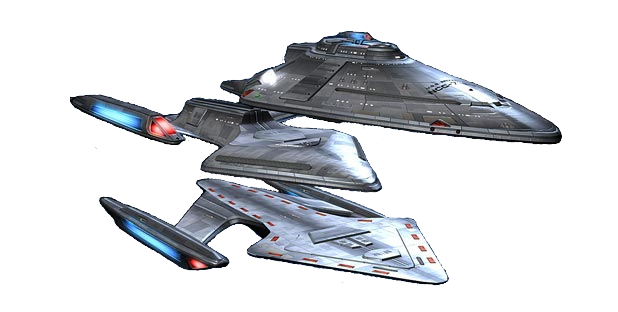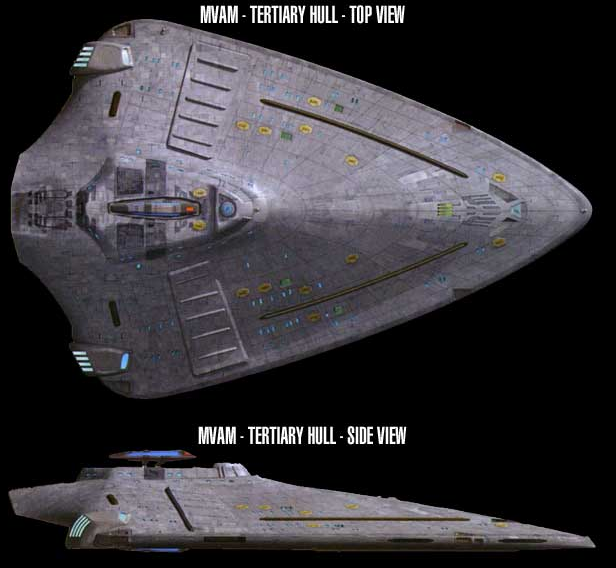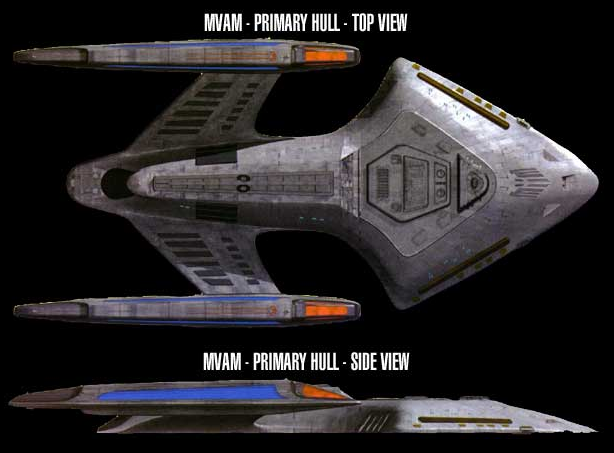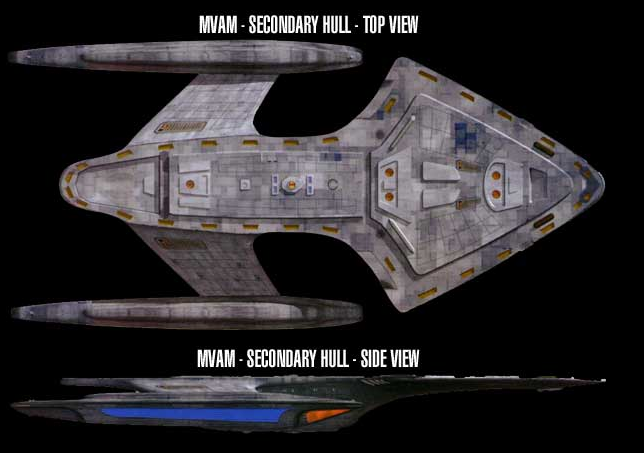Ship
Created by Sascha Oakheart on 22 Feb 2013 @ 7:40pm

UNDER CONSTRUCTION
The Prometheus-class is one of if not the most advanced Starfleet vessels in service as of the late 24th century. The Prometheus underwent many extended trials (both simulated and physical) and is the culmination of several separate research projects which were combined into one prototype test-bed vessel. Since it was so highly classified and possessed a hitherto unseen degree of automation only four Starfleet officers were trained on how to operate the Prometheus' systems before the vessel was deemed ready for active duty.
Among the Prometheus' state of the art features were the advanced type XII phaser arrays, quantum torpedoes, photon torpedoes, regenerative shield and Metaphasic shields augmented by a polaron modulator, and ablative armor with underlying Parametallic hull plating.
The Prometheus' warp engines were designed to make the Prometheus THE fastest class of ships in the fleet, with a cruising speed of warp 9 and a maximum speed of warp 9.995 (due to its tetryon warp plasma equipped warp nacelles). These speeds being standard, it was deemed necessary to develop a specialized navigation system, the RAV/ISHAK Mod 3a warp celestial guidance system, specifically designed to handle the ship's high warp capability. The warp engines of the Prometheus Class were based on a scaled down version of the Sovereign class' warp nacelle design, which eliminated subspace distortion effects inherent to standard warp drives without the use of variable geometry nacelles.

A unique feature included in the Prometheus design was the multi-vector assault mode, which allows the ship to split into three semi-independent sections (or fully independent sections if there are sufficient crew members onboard) that could each deliver massive force against an enemy target. All three sections are warp-capable.
Combined with the extensive automation, the Prometheus can be run by as few as four people. To allow this system to function it was again deemed necessary to develop a customized system for the ship, this one being the M16a tri-core bio-neural gel pack isolinear III processor.
In addition to standard automation systems, the design also featured omni-directional holo-diodes on every deck, which allowed the ship's Emergency Medical Hologram access all areas of the ship (most EMHs are confined to sickbay only).
From its inception, the Prometheus Class was intended as a deviation from standard Starfleet vessels, which are geared primarily for exploration. Along with the Defiant and Sovereign Classes, the Prometheus was Starfleet's response to rising threats from the Borg, Romulans, and eventually the Dominion. While the ship does have extensive scientific and diplomatic capabilities, it excels in tactical arenas. It's more heavily armed than ships in excess of twice its size, and it's got shielding and power systems to match, as well as a few unique design considerations.
Pursuant to Starfleet Exploration & Defense Directives the following objectives have been established for the Prometheus Class Starship:
- Provide a multi-mission mobile platform for a wide range of scientific and explorative research projects.
- Replace Excelsior, Ambassador, and Nebula class Starships as the primary instrument of Federation deep-space defense.
- Provide autonomous capability for full execution of Federation defensive, cultural, scientific, and explorative policy in deep space or border territory.
- Serve as a frontline vessel during times of war and emergencies.
- Provide a mobile platform for testing and implementation of mission-specific or new technology of any kind.
For Detailed Information:
- Construction History
- Operating Postures:
- Primary Systems:
- - Computer Systems
- - Propulsion Systems
- - Tactical Systems
- - Navigational Systems
- - Communication
- Secondary Systems:
- - Transporters
- - Holographic Systems
- - Universal Translator
- - Tractor / Repulser Beam
- Departments:
- - Command
- - Security/Tactical
- - Operations
- - Engineering
- - Science
- - Medical
- - Diplomatic
- - Marine Corps
The Prometheus Project was the research program initiated in 2359 as a project to design a starship whose sections each were equipped with a warp drive and reorganized into a combat ship program to develop the schematics for the Prometheus-class starship and construct the class prototype, the Prometheus. When the project was re-organized into a combat ship design program in 2364 it was decided by Starfleet Command to keep the Nebula-class USS Prometheus in service as a cover for the Prometheus class Project.
The 2359 version of the Prometheus class Project was created to explore the possibility of a true multi-section vessel able to separate into at least two independent sections, each with a fully functional warp drive of its own. One would be capable of launching an attack with almost the full ships weaponry, at high speed and maneuverability. The other, comprising the scientific, diplomatic and accommodation sections would clear the area at high warp carrying the civilian complement. Much of the technology being developed for the Intrepid-class project was included in this design, with the result that the theoretical model finalized in 2363 bore a close resemblance to the Intrepid herself.
In 2364 Starfleet was considering moving to construction of the space frame of the multi-section starship. However, during this year, contact with the Romulans was re-established when the USS Enterprise (NCC-1701-D) encountered a Warbird at the Neutral Zone. Since the Warbird appeared to outgun the Enterprise - then Starfleet’s most powerful ship - by a considerable margin, Starfleet was confronted with what appeared to be a powerful and aggressive enemy. As part of their response, Starfleet requested a complete re-design of the multi-section starship. The new requirement called for an almost totally re-designed vessel; the ship would be in three sections, each of which would have an independent warp drive system. The scientific and diplomatic sections were mostly removed in favor of increased armament and power for the weapons. In place of the type-VIII phaser arrays that the original ship had shared with the Intrepid class, the type-XII phaser arrays from the Sovereign-class project were included. The shield system was upgraded with the auto-modulating shields of the Sovereign class. The advanced warp engine design included many elements of the Sovereign class, while the ablative armor, high capacity structural integrity fields and quantum torpedoes developed in conjunction with the Defiant class project were also included. The computer system was upgraded to a custom built system designated the M16a tri-core bio-neural gel pack isolinear III processor and the navigational system installed was a custom RAV/ISHAK Mod 3a warp celestial guidance system specifically designed to handle the ship's cruising speed of Warp 9 and maximum speed of Warp 9.99.
This technology combined to make the new starship one of the most massively armed and armored vessels of its size ever contemplated, let alone built. The small size combined with incredible speed and maneuverability when in multi-vector assault mode.
When the prototype USS Prometheus was launched in 2374 it was rated at having a combat capacity nine times that of the equally-sized Intrepid class, while her Type XII Phasers made her a formidable foe for any vessel in the alpha quadrant. These systems were so advanced and cutting edge that the Romulan Empire risked a war by attempting to intercept and commandeer the prototype vessel during its field trial phase. Their goal was to secure the Prometheus and navigate it into Romulan space to be retrieved by the Tal Shiar, for eventual analysis, and back-engineering of some of its advanced systems. Fortunately for the security and integrity of the Federation, the Romulans onboard were thwarted by the mark 1 EMH from the starship USS Voyager and the then-installed mark 2 EMH, before the Tal Shiar task force was engaged by a small band of Starfleet vessels spearheaded at first by the USS Bonchune then the USS Akira who forced the remaining Warbirds to retreat.
The performance of the Prometheus during this accidental live-fire trial exceeded all expectations for the ship. With Starfleet losing ground against the Dominion, the class was moved into production. Although two of the class did participate in the Battle of Cardassia, the Prometheus class ships arrived in too limited numbers and too late to make a significant impact on the war as a whole. Despite their late arrival on the scene the Prometheus class was elemental in securing the borders and projecting the Federations strength as Starfleet replenished its losses.
Return to Menu- Standard Flight Mode

The ship spends the vast majority of its life in Standard Flight Mode (SFM). In SFM, the ship's two main warp cores are connected and act as one. The ship's four main warp nacelles work in tandem to generate an extremely efficient and finely tuned warp field, allowing this class to reach a maximum emergency warp speed of 9.982 for 12 hours. This is faster than virtually any other class of ship in the Federation, and is believed to be among the top five fastest known ship designs in the Alpha and Beta Quadrants.
- Multi Vector Assault Mode (MVAM)

If the ship encounters a battle situation, the Commanding Officer may choose to activate Multi-Vector Assault Mode (MVAM). In MVAM, the ship splits into three independent sections, all of which have warp capability and a powerful weapons load out. The sections of the USS Achilles are labeled somewhat differently, due to its trinary nature and more militaristic function. They're labeled in order of strength. Therefore, the saucer section, which on any other Starfleet class is referred to as the Primary Hull, is actually the Tertiary Hull on the USS Achilles, since it's the weakest section. The ship's middle section is the Primary Hull, being the most heavily armed. All facilities are labeled according to section. Thus, all primary facilities are in the Primary Hull, and so on.
Each section has its own Bridge, which are all activated and fully crewed during MVAM. One additional item of interest: nearly a third of the ship's weaponry is hidden during SFM and only becomes available during MVAM.
MVAM Sectional Descriptions:

This is the Tertiary Hull, or alternatively, the Saucer Section. It is the weakest overall, even though it technically has a greater armament than the other two sections. The main difference that causes its lower overall strength is the fact that it doesn't have as great of a power generation capacity, and a huge percentage of what it DOES have is channeled into the shields. This gives it shield protection almost the equal of the other two sections, but severely impacts its ability to use its phasers.
This section is the heaviest of the three, and the least maneuverable as well. Normally this section would participate in any battles along with the other two, but if it's an expected suicide mission, this section can be used as a warp-capable escape pod for all nonessential crew.
While this section is warp capable, it's not able to manage the high warp speeds the other two sections can. This is because it's got a smaller, secondary warp core, designated as a Class XVI Tri-MARA MicroCore, developed specifically for this ship class. This core provides enough power to run full shields and all critical systems. It's also sufficient to power the weapons, but it's not capable of generating the sheer energy release the ship's main core can, so this section can't fire the main phaser banks as often or for as long as the other two sections can. Finally, this core is connected to another of the ship's unique design considerations. The Tertiary Hull features two retractable Micro-Warp Nacelles.
In standard flight mode, these nacelles are retracted into protective shielded pockets and they don't receive power unless the ship is attempting emergency warp speeds. When the order is given to activate Multi-Vector Assault Mode, among the very first things that happen is that these two small nacelles are powered up. This is a safety feature, and enables the ship to separate even while at warp with very little risk. The only restriction is that the ship must drop to warp 8 or lower, since that is the fastest speed this section can sustain. As the saucer separates from the Primary Hull, the two small nacelles extend out from their protective pockets, in order to create a more efficient warp field than they would be able to from inside the pockets.
During MVAM, this section is commanded by the ship's Second Officer.

This is the Primary Hull, or alternatively, the Upper Stardrive Section. It is the Primary Hull because although it isn't technically the most heavily armed, it is the most powerful section overall, and is the most important section, being the one that connects the other two. The Primary Hull also contains all of the ship's most important areas. In addition to the Main Bridge, the Primary Science Lab, Main Engineering, Primary Security, and the Main Sickbay are all located here. The Primary Computer core is here as well.
The Primary Hull would function pretty well as an independent Starship in its own right. It's heavily armed for a ship of this size, and it has shield generation capability almost equal to that of an entire upgraded Galaxy Class starship. It's the smallest of the ship's three sections, and therefore the most highly maneuverable. With the right pilot at the helm, this section can outmaneuver a much smaller Defiant Class starship. In terms of sheer brute strength, this section's Type XII phasers, Pulse Phasers, and Torpedo tubes allow it to outgun any Federation starship up to and including an Akira Class ship. When it's backed up by the other two sections, the mini-task force becomes a true force to be reckoned with, easily capable of inflicting catastrophic damage on much larger foes in a matter of moments.
This section carries two of the ship's primary warp nacelles, and half of the integrated warp core, designated as a Class XVIII Multi-MARA SuperCore. This section can travel at high warp, although it's not as fast on its own as the integrated ship is.
During MVAM mode, this section is commanded by the ship's Commanding Officer.

The lower section, properly referred to as the Secondary Hull or Lower Stardrive Section, is the second-most powerful section of the ship. Since it doesn't have any pulse phasers and has one less torpedo tube than the Primary Hull, it's got a slightly lower overall firepower. However, in virtually all other aspects it's nearly identical to the Primary Hull. Its shields and power systems are just as tough as the Primary Hull, it too has half of the ship's integrated main warp core, and two of the primary nacelles. It can maintain a speed equal to that of the Primary Hull on its own. If the Primary Hull and Secondary Hull are combined together, they can match all of the rated speeds of the integrated ship except for the emergency warp factor, which the integrated ship requires all three warp cores to achieve.
During MVAM, this section is commanded by the ship's Executive Officer.
Return to MenuThe normal flight and mission operations of the starship are conducted in accordance with a variety of Starfleet standard operating rules, determined by the current operational state of the starship. These operational states are determined by the Commanding Officer, although in certain specific cases, members of the crew or even the Computer can initiate a higher alert status. The major operating modes or alert status’ are:
Yellow alert Red alert Blue Alert Intruder Alert Grey ModeA yellow alert is the second highest alert signal status on Starfleet vessels, one stage below red alert. It designates a ship-wide state of increased preparedness for possible crisis situations. In this status, shields and deflectors are brought to full power; however the weapons systems remain off line.
A yellow alert may either be activated manually by any member of the crew in preparation for a tactical or environmentally hazardous situation, or automatically upon detection of unknown or hostile spacecraft, or upon detection of certain system malfunctions. If the situation escalates, a crewmember or the main computer will order a red alert.
During yellow alert the on duty crew will prepare for possible combat or hazardous conditions. Any senior staff that are not on duty will be contacted and ordered to attend their positions.
A red alert is the highest alert signal status on Starfleet vessels, one stage above a yellow alert. In this status, weapons systems and shields are brought to full power, as the ship prepares for combat. Red alert is also ordered during various other emergency situations, such as a ship being boarded, radiation exposure, a security alert, massive systems failure, an imminent warp core breach, and an evacuation order among others. The red alert may either be activated manually by any member of the crew or automatically when a ship receives damage or upon detection of certain system malfunctions.
During a red alert, lights are dimmed (to allow better viewing of the LCARs system), alarms blare, and computer terminals show constant red graphics. Upon activation of the red alert all crewmembers are required to attend their designated combat stations. All civilians will move to designated civilian 'safe zones'. In addition to this, there are a number of things that occur once a red alert is sounded:
- The ship's weapons - phasers and photon torpedoes/Quantum torpedoes - are brought to ready status.
- All crew members are to report to duty, whether manning their primary duty station or a secondary duty station within five minutes. Those crew members asleep at the time are to report to duty within fifteen minutes. Secondary stations can include medical duty. On larger ships a good portion of the crew receives training as medical technicians. Much of the crew is used as "damage control", where the crewmembers presumably help to fix minor damage to the ship and perform basic engineering tasks, under the direction of the primary engineering team.
- The deflector shields are brought to full power and raised.
- On starships that have the ability to separate the saucer section, the crew prepares for possible separation. For a Prometheus Class ship: Auxiliary warp cores are brought online, Secondary and tertiary sickbays are manned and readied, Marine Corps personnel are distributed to each section, and the each auxiliary bridge is manned incase MVAM is ordered. (f automated the sections will be controlled from the main bridge. If not automated each auxiliary bridge will await its respective commanding officer.)
- The crew makes sure escape pods access ways are clear, so that if crew members and civilians need to evacuate the starship they can get to the escape pods without any interruption.
- Security or Marine teams are stationed at key areas throughout the ship.
- Sensors record and track the locations of all individuals aboard the ship. This is used to determine if unauthorized access by an intruder occurs. (The ship's computer also helps with this function)
- All security teams are placed on standby status.
Prometheus class vessels are capable of atmospheric entry and egress with equipment worked into the physical design of the starship. Each vessel is equipped with anti-gravity generators as well as impulse and RCS lifters strategically placed at the mass and stress points on the bottom portion of the engineering section. During Blue Alert, the Prometheus class lowers the projection sphere of the deflector shields and assumes an angle of attack perpendicular to the angular rotation of the planetary body if it has an atmosphere. This allows the vessel’s shape to work as a lifting body with air traveling under the broad and flat saucer and under the wing-like nacelle struts. Once in the atmosphere, navigation is controlled with RCS thrusters and use of the aft impulse engines.
It is standard procedure to lower the landing gear at approximately 2500m above the Landing Zone (LZ) surface, regardless of LZ altitude. This minimizes the drag on the vessel. Once prepared for landing, Aft impulse engines are shut down and four vents on the ventral hull are opened. These vents cover the ventral impulse thrust plates. Impulse engines in miniature, the thrust plates serve only to provide lift to the Prometheus class as the anti-gravity generators effectively reduce its weight. The RCS thrusters provide final maneuvering power.
Once on the ground, crew or equipment can be transported to the surface from the vessel, or use the ship’s turbolift system that connects to channels inside the landing struts themselves, and open out near the ‘feet’.
Intruder alert is an alert status on Federation starships and space stations. It can be declared at any time, by any member of the crew upon sighting an intruder on board. It can also be activated automatically based on predefined criteria, such as entering a restricted area. The alert is announced by audio and crew members are to take appropriate action.
Grey mode is an alert status used aboard Federation starships. When in grey mode, the starship runs on reserve power, cutting power to non-essential decks and ship systems. It allows for maximum power conservation, budgeting a starship's energy resources during a time of crisis, while still maintaining an operating status. Grey mode can be invoked during a massive fuel shortage, or when the tactical situation requires a reduction in discretionary energy usage. A number of ship systems are either reduced to a lower operating status, or shutdown completely, including:
- The warp core, which is brought to a cold-shutdown
- Inertial damping and structural integrity systems are operated at minimum levels
- Tactical and lateral sensors are only used for primary ship functions
- Deflector systems are either shutdown, or reduced to minimum levels for non-flight operation
- Weapons systems, phasers and photon torpedo launchers, are brought off-line
- Shuttlebay operations are suspended, as the shuttlecraft can provide energy support if necessary
- Life support systems are brought to minimum levels, and shutdown on non-essential decks
- Transporter usage is terminated
- Turbolift usage may be suspended at the commanding officer's discretion
- Food replicators are not used, and emergency rations are distributed
- Holodeck usage is terminated
- The recycling of non-essential items, which can be broken down into raw matter patterns by the replicator, is commonly practiced. Preserving the replicator for usage only during critical situations (such as replicating repair tools, medicine, etc.) can help extend the energy resources of the ship.
Starships can be forced into this condition, due to tactical situations or spatial phenomena, which can also coincide with a red alert
Return to MenuThe Prometheus was outfitted with a state of the art, custom computer system programmed with the most up to date LCARS computer software and computer database. The computer system is formally known as the M16a tri-core bio-neural gel pack isolinear III processor. The M16a tri-core bio-neural gel pack isolinear III processor is a variant on the standard mark sixteen multi-tronic computer equipped with third generation Isolinear circutry and bio-neural gel packs. The differences between a M16 bio-neural gel pack isolinear III processor and a M16a tri-core bio-neural gel pack isolinear III processor are the addition of a third computer core, as compared to the standard two, to assist in coordinating the second docking system and speed up communications while the ship is in multi-vector assault mode, and the use of second generation bio-neural gel packs which contain one point five times the synthetic neurons as standard gel packs resulting in a fifty percent increase in data transmission and processing.
In addition to the main computer system the Prometheus is equipped with two secondary cores which are brought on-line during the Multi-Vector Assault Mode and take over the main computer functions for those sections for the duration of the separation.
Number of computer cores: Three
The primary computer core is accessed in the control room on Deck 5 in amidships for maximum protection. It covers four decks and extends from Deck 3 to Deck 6. The Auxiliary cores, covering three decks each, are located on Decks 4 thru 6 and 12 thru 14. Both are fed by two sets of redundant EPS conduits as well as primary power.
Core Type:
The M16a series computer core is built under contract for the Prometheus class vessel by Krayne Systems, an independent contractor based on Bynar. The structure of the computer is similar to that of most other supercomputing systems in use by Federation vessels with stack segments extending through the ship forming trillions of trillions of connections through the processing and storage abilities of modern isolinear chips. Cooling of the isolinear loop is accomplished by a regenerative liquid helium loop, which has been refit to allow a delayed-venting heat storage unit for "Silent Running.” Typically, requirements on the computer core rarely exceed 45-50% of total core processing and storage capacity. The rest of the core is utilized for various scientific, tactical, or intelligence gathering missions - or to backup data in the event of core damage.
Bio-Neural Gel Packs, referred to typically as BNGs, Bio-Neural Gel Packs were an innovation in shipboard data processing and routing. Mounted at strategic locations along the ODN pathways, each BNG consists of an artificial bio-fluid that allows transmission of neural signals. The heart of the BNG is a packet of neural clusters, grown copies of strands similar to those found in the brains of sentient beings. These clusters give the ship’s computer ‘instinctive’ data processing and routing ability as well as allowing the ship’s computer to utilize ‘fuzzy logic’ to speed up probability calculations much as a living, breathing entity would. Though a breakthrough in shipboard technology, the BNG has shown one liability in that the biological components can contract contagions and make the ship ‘sick’.
Operation System: LCARS
LCARS is an acronym for Library Computer Access and Retrieval System, the common user interface of 23rd & 24th century computer systems, based on verbal and graphically enhanced keyboard/display input and output. The graphical interface adapts to the task, which is being performed, allowing for maximum ease-of-use. The Prometheus class operates on LCARS version 11.3a to account for increases in processor speed and power, eliminating limitations discovered in the field in earlier versions, and increased security.
Reaction Control System
Starfleet's standard issue Reaction Control System, the heart of the Reaction Control or RCS thrusters. The RCS thrusters are the standard maneuvering thrusters found on Federation starships and shuttle craft. The thrusters utilize interstellar deuterium collected by the Bussard collectors to generate thrust. In order to conduct a full, emergency thruster shutdown, deuterium must be vented from the system.
Type: Standard Version 3 magneto-hydrodynamic gas-fusion thrusters.
Output: Each thruster quad can produce 3.9 million Newtons of thrust.
Impulse Drive
The Impulse Drive, like all impulse drives, are essentially a magneto-plasma-dynamic thruster, consisting of a fusion reactor, an accelerator-generator, a space-time driver coil assembly and a vectored thrust manifold to direct the plasma exhaust. The fusion reaction generates highly energized plasma. This plasma, or "electro-plasma", can be employed for propulsion, or can be diverted to the power transfer grid, via EPS conduits, so as to supply power to other systems. The accelerated plasma is passed through the driver coils, thereby generating a subspace field which improves the propulsive effect.
Type: Twin fusion-powered Krayne-21 impulse drives mounted on the aft section of the saucer and on the aft section of the nacelle pylons (these drives are utilized only once separated) . Built by Krayne Industries, the K-21 drives were specially designed for the Prometheus with tolerances built-in for the ship specific size and geometry, as well as variable ethereal vanes for direction of hydrogen flow. Output: The impulse engines can propel a starship at speeds just under .25c, at “Full Impulse” and an upper ceiling of .80c at three quarters the speed of light. Generally, Starfleet Vessels are restricted to .25c speeds to avoid the more dramatic time dilation effects of higher relativistic speeds. However, such restrictions can be overridden at the behest of the ship’s captain.Warp Drive
The warp drive on the Prometheus class uses a Tetryon warp plasma warp drive system which operates in the same manner as non-Tetryon warp plasma warp drive systems except for the fact that Tetryon warp plasma is used instead of normal electro-plasma to generate a superior propulsive effect. The efficiency of a warp core is in part dependent on its height -the longer a core is, the more accurately the matter and antimatter streams can be controlled. The core thus operates in a manner similar to any standard model, achieving high efficiency through the long core design. An added benefit of using tetryon plasma; when released into space it temporarily disrupts any warp field it comes into contact with, essentially "stalling" said vessel's warp drive which forces it to go to Impulse.
The warp drive on the Prometheus is also augmented by the usage of Starfleet's most advanced design of Cerenkov emitters and the application of Quantum field assisted tetyron plasma technology which consists focusing a low power quantum field through the ship's main navigational deflector to generate minor changes in local space curvature which resulted in the Prometheus' cruising speed of warp nine and maximum speed of warp nine point nine nine requiring only sixty-one point five percent of the amount of energy that was required to maintain the same speed prior to the quantum field projection refit.
Warp Core Ejection
Though rare, starships occasionally face the horrible concept of a warp core breech. As the primary power source for a starship, the explosive power of a warp core far surpasses the superstructure and structural integrity field strengths and most often ends in the complete destruction of the starship and anything within a 30 kilometer blast radius.
Modern starships have been equipped for this possibility and have the capability to eject their warp core. Due to the unique nature of the Prometheus class, it has been equipped with multiple ejection ports, one for each section. Magnetic rails inside the channel accelerate the core once disengaged from the ship and ‘fires’ it as far as 2000 meters away from the ship. The ship then moves away from the area as fast as possible under impulse power. Should the core be ejected and not go critical , as with all starships, the warp core can be recovered by use of shuttles, tractor beams, and careful manipulation.
Return to Menu
Return to Menu
The Prometheus was equipped, during its construction, with the navigational deflector design from the Akira-class enhanced with elements from the Sovereign-class starship's navigational deflector design. The enhancements allow the navigational deflector to operate with a marked increase in efficiency at higher warp speeds.
In spite of the fact of that the deflector design was used for a vessel with a lower maximum warp speed the Starfleet designers in charge of the Prometheus Project felt that the design was still suitable (with minor modifications) since it was designed for a vessel with a wider beam measurement and a greater bow to stern length and a mass roughly 3.59411 times greater then that of the Prometheus.
The deflector is located just forward of the primary engineering spaces. Composed of molybdenum/duranium mesh panels over a tritanium framework (beneath the Duranium-Tritanium hull), the dish can be manually moved ten degrees in any direction off the ship's Z-axis. The main deflector dish's shield and sensor power comes from two graviton polarity generators located on Deck 10, each capable of generating 128 MW, which can be fed into two 480 millicochrane subspace field distortion generators.
Configuration of the dish differs from standard, with a setup geared toward high-speed and balanced against efficiency. The dual G-P generators are mounted with their own emitters that flank the main emitter assembly in the center of the dish.
Return to MenuStandard Communications Range: 30,000 - 90,000 kilometers
Standard Data Transmission Speed: 18.5 kiloquads per second
Subspace Communications Speed: Warp 9.9997
Holographic Communication System: (see: Holographic Systems )
Return to Menu
Number of Systems: 7
Personnel Transporters: 3 (Transporter Rooms 1-3)
Max Payload Mass: 900kg (1,763 lbs)
Max Range: 40,000 km
Max Beam Up/Out Rate: Approx. 100 persons per hour per Transporter
Cargo Transporters: 2
Max Payload Mass: 800 metric tons. Standard operation is molecular resolution (Non-Lifeform).
Set for quantum (Lifeform) resolution: 1 metric ton
Max Beam Up/Out Rate (Quantum Setting): Approx. 100 persons per hour per Transporter
Emergency Transporters: 2
Max Range: 15,000 km (send only) {range depends on available power}
Max Beam Out Rate: 100 persons per hour per Transporter (300 persons per hour with 4 Emergency Transports)
Return to Menu
Return to Menu
Type: Multiphase subspace graviton beam, used for direct manipulation of objects from a submicron to a macroscopic level at any relative bearing to the Intrepid class. Each emitter is directly mounted to the primary members of the ship's framework, to lessen the effects of isopiestic subspace shearing, inertial potential imbalance, and mechanical stress.
Output: Each tractor beam emitter is built around three multiphase 15 MW graviton polarity sources, each feeding two 475-millicochrane subspace field amplifiers. Phase accuracy is within 1.3 arc-seconds per microsecond, which gives superior interference pattern control. Each emitter can gain extra power from the SIF by means of molybdenum-jacketed wave-guides. The subspace fields generated around the beam (when the beam is used) can envelop objects up to 920 meters, lowering the local gravitational constant of the universe for the region inside the field and making the object much easier to manipulate.
Range: Effective tractor beam range varies with payload mass and desired delta-v (change in relative velocity). Assuming a nominal 15 m/sec-squared delta-v, the multiphase tractor emitters can be used with a payload approaching 2,330,000 metric tonnes at less than 2,000 meters. Conversely, the same delta-v can be imparted to an object massing about one metric ton at ranges approaching 30,000 kilometers. Primary purpose: Towing or manipulation of objects Secondary purpose: Tactical/Defensive
Return to MenuReturn to Menu
Return to Menu
Return to Menu
Return to Menu
Return to Menu
Return to Menu
Return to Menu
Return to Menu
Return to Menu
Categories: Phoenix Information


